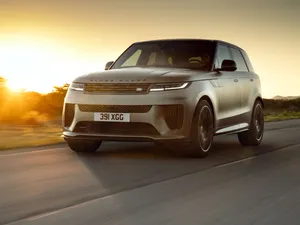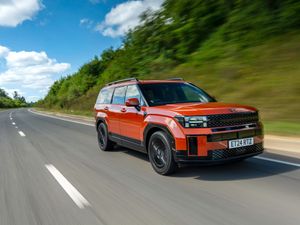First Drive: The Sport SV pushes Range Rover dynamics to a new level
The Sport SV has been equipped with loads of tech upgrades, but do they combine to make a true-performance SUV? Jack Evans.

What is it?

Range Rover has a habit of making some quite lairy four-wheel drives. The previous-generation Sport SVR, after all, was one of the go-to models for drivers after a high-riding SUV that could out-accelerate a lot of supercars and make a real clatter from the exhaust while it did so. It was immensely popular, too, which is probably why Range Rover has returned to create a go-faster model of its current Sport with this – the SV.
But while it might’ve been tempting to bung a large engine into the Sport and leave it at that, Range Rover has given the SV a far more comprehensive series of upgrades to make this car as sharp and as capable as ever – without losing any of the well-regarded aspects that you’d expect from a ‘traditional’ Range Rover.
What’s new?

There’s a lot more going on here than just a slightly beefed-up exterior. There are some particularly eye-catching design features available on the SV; new 23-inch carbon fibre wheels which shave 76kg off the car’s weight, hydraulic interlinked suspension that keeps the ride controlled during all types of driving and there’s even ‘in-car sensory audio technology’ that can make your seat vibrate in the same tempo as the track you’re listening to.
The SV acts as a halo for the entire Sport range, too, and while a limited run has sold out entirely, Range Rover has said that ‘if there is demand, they’ll build more’ – so we’d bank on plenty of these rolling out from the factory in the future.
What’s under the bonnet?

Range Rover hasn’t picked its 5.0-litre supercharged V8 for the SV, instead opting for the twin-turbocharged 4.4-litre V8 which you’d find in some high-performance models from BMW. With 626bhp it makes the SV the most powerful Range Rover to date, with 750Nm of torque contributing to a 0-60mph time of 3.5 seconds and a top speed of 180mph.
Of course, efficiency isn’t the top priority in this car but, because of that 4.4-litre V8 – rather than the older 5.0-litre – it actually produces 15 per cent less CO2 than its SVR predecessor, with total output standing at 270g/km. Range Rover claims up to 23.7mpg, too, but expect that to drop considerably during spirited routes – we saw around 19mpg during mixed driving.
What’s it like to drive?

The good news about the SV is that it behaves – during daily driving – like a ‘regular’ Sport; there’s that lofty driving position and soft edge to the ride that lends itself to long-distance journeys which fly by. Naturally, it’s a stiffer setup and there’s the odd jostle, but the way the SV handles lumps and bumps is remarkable – particularly for something riding on such massive wheels. We tested both the carbon and regular iron brakes and though the latter might not have the same gravitas, they’re more than capable enough of bringing the SV to a hurried stop when you need to.
We got the chance to test the SV around the famous Portimao circuit and it behaved in a way a heavy SUV has no reason to behave. It maintained composure and agility throughout the circuit’s bends and this translates to a very polished driving experience. We’d just say that though this 4.4-litre V8 might be potent, it doesn’t feel quite as brutally quick as the SVR which preceded this model – it sure is fast, but despite the 3.5-second 0-60mph time, doesn’t take your breath away from a standing start in quite the same fashion. It sounds more subdued, too.
How does it look?
The standard Sport is already quite a handsome thing and Range Rover seems to know that – it hasn’t mucked about too much with the way this performance version looks. There’s the option to have a contrast bonnet – in classic SVR fashion – but there are only three exterior colours to choose from, which feels a bit limited. There’s a redesigned front end with a chunkier splitter, while around the back there’s some carbon fibre badging to reflect this car’s sportier nature.
Naturally, the 23-inch carbon-fibre wheels are a big talking point here and at over £3,000 for the set they aren’t cheap. Fortunately, the standard alloys still look superb while around the back the quad exhausts give an indication of the engine beating away up front.
What’s it like inside?

The latest Sport is already a fine place to be from the inside, but some tweaks and additions have been made here and there in the transition to SV. Chief among them are the large bucket seats for those up front – they’re not too heavily bolstered and, in fact, could be a little roomy for smaller people. There’s plenty of space in the back, too, though the new bucket seats do block some visibility for whoever is sitting in the rear of the SV.
As on the standard car, there’s a little too much gloss black plastic surrounding the switchgear area and this clangs slightly with the price tag of this car. It would’ve been much nicer to have this section finished in carbon fibre instead, with a leather-clad gear selector a better choice to the cheap-feeling plastic one that sits there as standard. The good news is that the space and versatility that makes the standard Sport so usable on a day-to-day basis hasn’t been lost here.
What’s the spec like?

Where a lot of the SV’s price is being spent is going on underneath. It has been radically upgraded mechanically compared with the standard car and, in our opinion, this is much preferable to a model which looks awe-inspiring but can’t deliver the kind of driving experience that you expect. However, the tech which is aboard all works superbly, with JLR’s Pivi Pro system continuing to impress with its ease of use and variety of features.
We also like the driving mode button which has been installed at the lower part of the steering wheel as it allows you to quickly cycle through the different vehicle settings, while the driver assistance mode button on the wheel – which means you can quickly lessen the interference of these often-annoying features – is a great call and makes disabling these systems much easier.
But it doesn’t come cheap , as at £185,360 for the launch version, the SV costs more than double the price of a regular Range Rover Sport. Not that it has stopped buyers, as the initial run is all fully allocated,
Verdict
The Sport SV is the kind of car that die-hard sporty Range Rover fans were always calling out for. As a tip-top version of an already-popular model, you could argue that it was always going to sell – regardless of how well or poorly it was set up. However, the extensive lengths that Range Rover has gone to in order to make the SV steer, accelerate and brake as dynamically as possible must be applauded – this isn’t simply a regular Sport on fancy wheels.
It may not be the last word in performance SUV sharpness, but given the level of driver involvement it delivers – particularly in a car weighing well over 2.5 tonnes – the SV is a model which you can’t help but feel impressed by.





